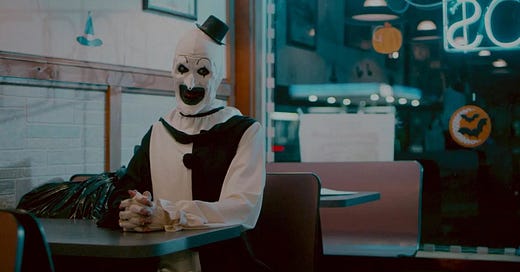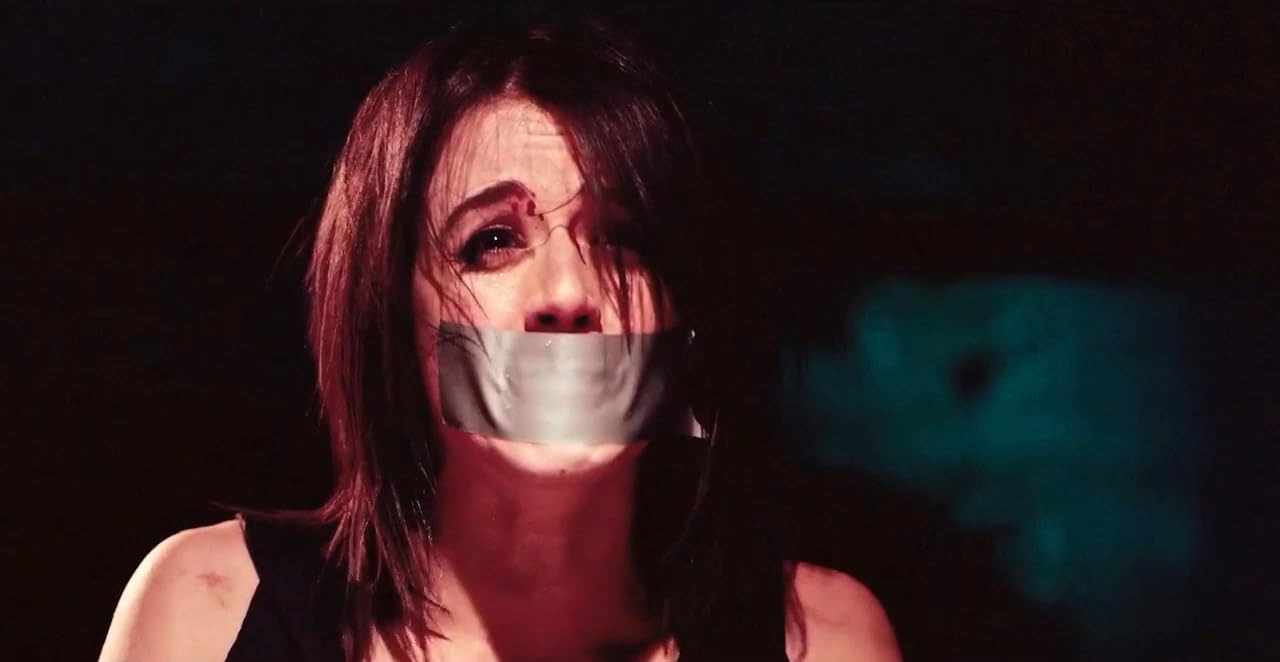8/10
Terrifier shows there’s still plenty of juice left in the slasher-movie format when helmed by a sufficiently talented filmmaker. Writer, director, producer, editor, and makeup/special-effects artist Damien Leone manages to take this seemingly played-out subgenre and create a genuinely frightening and unnerving experience—combining dark atmosphere with memorable kills and gory practical effects that are just gratuitous enough.
At the centre of Terrifier is Art the Clown (David Howard Thornton), an instantly iconic horror-movie villain who ranks right up there with the holy trinity of 1980s slasher flicks: Michael Myers, Jason Voorhees, and Freddy Krueger. During the opening credits we see Art putting on his macabre clown makeup and costume, which are impressive enough to suggest the character might have a background working behind the scenes in horror films. Later we see Art sucking his thumb while a woman cradles him. Horror villains and mommy issues: name a more iconic duo.
Otherwise, all we know about Art is that loves to kill and torture people, remaining silent even when someone stabs him. Unlike other slasher villains, Art isn’t above using guns; he just wants to kill. Yet he also exhibits a twisted sense of humour—arguably funnier than that other killer clown named Arthur, whose own movie bombed this month unlike the latest Terrifier. Helped by impressive makeup and costuming, Thornton conveys all this through his mime-like performance. There’s also bizarre imagery like a bloodied Art riding around on a tiny bicycle, or dancing around nude wearing a victim’s hair and breasts.
As is typical for the slasher subgenre, the plot is as basic as it gets, though its setting on Halloween night offers extra atmosphere. Two young women, Tara (Jenna Kanell) and Dawn (Catherine Corcoron), are returning home from a night of alcohol-fueled partying when they find themselves being stalked by Art. Tara’s sister Victoria (Samantha Scafffidi) drives out to give them a ride home and gets more than she bargained for. Aside from a few scenes in a pizzeria, most of the action takes place in a creepy abandoned building, with Art’s would-be victims locked inside.
The heart of slasher films are the elaborate kill sequences that act as set pieces, and Terrifier offers some particularly gruesome examples that will stick with you. The horrifying standout is a scene in which a person hanging upside down is cut open with a hacksaw. We also see such novel images as a severed head that has been turned into a human jack o’lantern. The gore is shocking and visceral, but Leone wisely doesn’t linger on the images too long—maintaining a balance that emphasizes frightening viewers even while grossing them out. Working on a miniscule budget, the director consistently demonstrates his talent for practical effects work: from what I can tell, no lame CGI blood effects here.
Characters are underdeveloped, but that’s pretty standard for this genre. In the case of Art, we know just enough to maintain an aura of fearsome mystery and unpredictability. The other actors’ performances help bring more to the characters than what’s on the page, with Kenell the standout. Another vital component that elevates the film is Paul Wiley’s musical score, which incorporates creepy synths in a way that feels simultaneously retro and modern. “Terrifier Theme” has a simple recurring riff similar to the likes of John Carpenter’s Halloween theme, but the production is more evocative of 21st century synthwave.
The bookend scenes are interesting, revealing that the rest of the film is a flashback, but I’m curious to see if the first murder we see is followed up on in any of the sequels. While Terrifier allows usual tropes of this subgenre like the killer being able to quickly appear in different places, for the most part it operates according to real-world rules—until the end, when it takes a clear turn into the supernatural. The film might have been more unsettling without the standard “sting-in-the-tail” slasher ending; evidently Leone couldn’t resist leaving open the door for sequels.
Watching Terrifier, I couldn’t help but contrast it to the 2009 Friday the 13th remake, which I had rewatched the night before. I enjoy the latter, probably the most slickly made movie in that series. But it brought nothing new to the slasher genre and, like many slashers, was so clichéd as to be more funny than scary. Terrifier marks a return to the genuinely scary roots of the genre in John Carpenter’s 1978 Halloween, but with an updated filmmaking sensibility and gory kills that—unlike inferior efforts such as the endless Halloween sequels—never overshadow the chills.






For the limited budget, this is surprisingly a high-quality horror flick if one has the stomach for it.